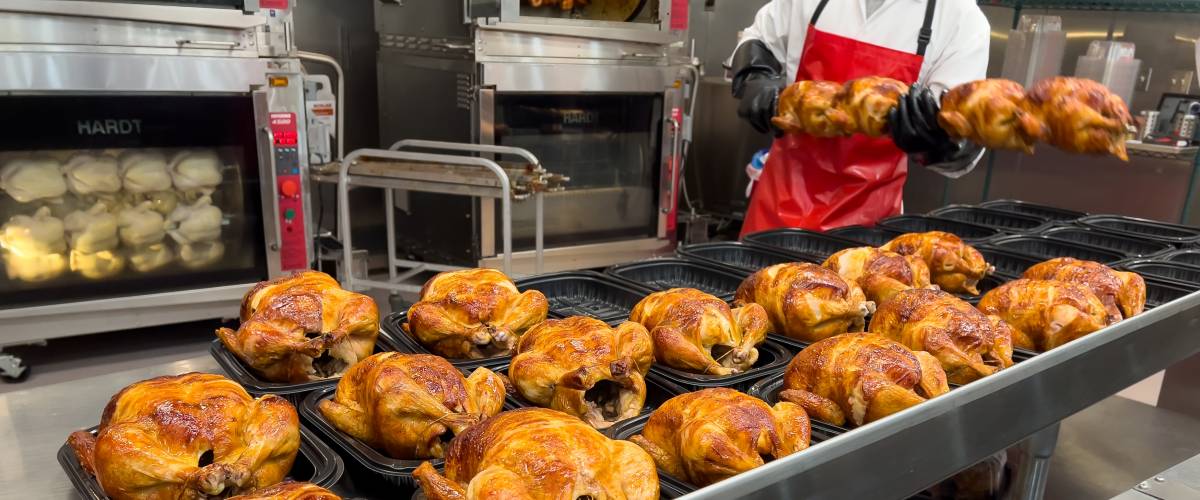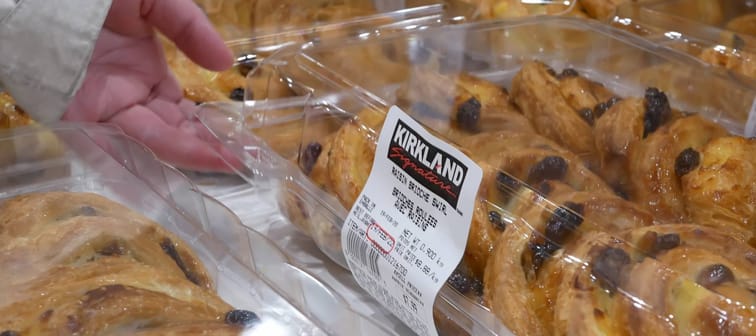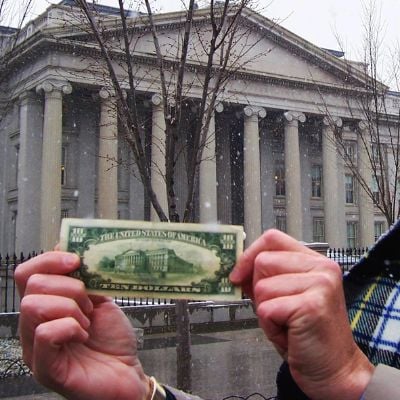1. They make it exclusive

Costco is notorious for being a members-only club — in order to buy a majority of their products, you need to shell out for their card.
While the mandatory membership definitely rankles some prospective customers, making the store exclusive benefits Costco by playing on the psychology behind cognitive dissonance.
Psychology site Very Well Mind says that cognitive dissonance is that uncomfortable feeling you get when you hold conflicting beliefs or attitudes. A sign of cognitive dissonance is trying to justify or rationalize a decision you’ve made — like, perhaps, buying a store membership.
Daniel Burstein, content and marketing expert, says that “[People] want to believe they made good decisions … if they bought a Costco membership because they believed it would save them money, now when they have a new purchase decision, they are more likely to buy from Costco.”
If you’re going to the store to get the deals pretty often, you begin to feel that the membership was worth it, and you can drop that discordant itching in your brain.
The members-only strategy also has a very simple benefit to Costco’s bottom line: Their 2023 annual report says revenue generated by their membership fees increased by 8% since 2022, for a total of $4.6 billion.
How to get a free $10 to invest in your future
An app called Acorns automatically rounds up purchases made on your credit or debit card to the nearest dollar and places the excess "change" into a smart investment portfolio. You get $10 immediately from your first investment.
Get $102. They use their private label

Costco has a big winner with their Kirkland Signature line.
Shoppers feel that they’re getting a good deal with these store-brand products and are often likely to buy them over other, more expensive options. As of 2021, the Kirkland label accounted for 25% of Costco’s total revenue, according to Forbes.
Customers trust the band, and the psychology of trust is often used in marketing, according to the Department of Psychology at USC.
The Costco “anti-brand” fosters a feeling of sincerity through visual and price cues, making their shoppers feel reassured that what they see is what they get.
They have to be careful with this trust, though. Costco knows that because of the limited number of products they sell, there’s less room for error in the quality of those products.
So, how do they ensure high quality on a low-cost store brand? It turns out that many Kirkland Signature products are the same as the big brands, just repackaged. That’s why, when you read the label on your coffee, often it says, “made with beans roasted by Starbucks.”
3. They move the merchandise around

If the reviews are to be trusted, Costco customers hate when their favorite item, say, a vat of Kraft peanut butter, suddenly disappears from the spot where they usually find it, forcing them to go on a hunt around the store.
This directionless walk of confusion is intentional on Costco’s part. It relates to the psychology behind treasure hunts and is a common retail technique.
According to Retail Customer Experience, when a customer walks up to where they thought that peanut butter would be and it’s no longer there, they will stick around to try and find it — while browsing through a number of tempting triggers.
The numbered aisles reinforce this wandering style of shopping, because without labels, customers have to walk through to know what’s on those shelves.
Retail Customer Experience points out that if you find something you weren’t expecting, or if you make an impulse purchase, it triggers a release of happiness chemicals; and who doesn’t like happiness?
You will at some point find that peanut butter — but on the way, you may also pick up 34 ounces of maple syrup, a cuckoo clock and 10 family-sized bags of chips.
Get paid to take surveys & make money online
Take surveys. Get PAID. Be an influencer. Share your opinion to help brands deliver better products & services.
Join now4. They stack it to the sky

In 1993, according to Britannica, Costco merged with the grandfather prototype of the bulk warehouse — Price Club, which had been founded in the 1970s by Sol Price.
Sol was big into the phrase, “Pile it high and watch it fly!”
He figured out that by stacking the merchandise vertically, the customer would associate the sky-high goods with abundance, and knowing there’s an abundance of a product makes you more willing to grab one for yourself.
Think about it. Have you ever been reluctant to grab the last slice of pizza in the box shared by your friends, or use up the last of the coffee creamer in the work fridge?
The same principle often applies to retail shopping. We’re conditioned to be reluctant to take from a dwindling stock, but if there’s more than enough to go around, you’re more likely to grab a box — or two — off the shelf.
By displaying these gargantuan stacks of products, Costco is signaling this abundance to the customer. Take whatever you need — but maybe ask an employee to borrow their step ladder.
5. They decorate as little as possible

Considering that, as of 2023, Costco was the sixth largest retailer in the world according to Forbes, you’d think they could dish out some cash to make the interiors of their stores a little more inviting.
But their stripped-down aisles stacked with shrink-wrapped pallets are designed to convince the customer that they’re getting the lowest price possible.
A 2002 study by the Harvard Business Review confirms that consumption is often driven by perceived cost, meaning that a customer is willing to pay what they think an item is worth.
Science Daily says that people frequently equate a product’s low cost with high value, but potentially with low quality as well.
Costco, however, wants their customers to think that they are getting high quality items at low prices — which, to be fair, they often are.
So, if customers start wondering how Costco is able to offer them those prices, there are cues all around them subconsciously saying that the store has cut other expenses, like aesthetic design and decorations, in order to offset that low price.
6. They run you around the racetrack

Fun fact: The first bulk warehouse store, Sol Price’s Price Club, opened their doors in 1976 — the cavernous location had previously been used as a San Diego airplane hangar.
Most Costcos are designed around what’s called a racetrack retail grid, which, according to Fast Company, will lead the customer around the entire store before getting to the check-out counters and the exit.
The staples — toilet paper, produce, eggs — are placed at the back of the store so that customers have to walk through the entire place before being able to grab their necessities, hopefully picking up a few non-essentials on the way.
7. They lead with a loss

Costco’s rotisserie chicken, sold at a mere $4.99, is renowned among customers. People love it for its flavor, its convenience and especially for its price tag.
In 2015, Costco’s chief financial officer said that the store was “willing to lose” an estimated $30-40 million a year on their fan-favorite chickens, rather than raise the price.
But if it loses the company money, why would they continue this practice? Unfortunately, it’s not because they love their customers so much; it’s more business-oriented than that.
This chicken is known as a loss-leader item, which is when a retailer will price an item lower than its market value in order to get customers into the store.
Knowing that they’ve saved money on that item, the customer now thinks that they have room to even out their bill, and will likely keep shopping.
8. They target suburbia

As financial website Investopedia points out, targeting suburban customers has been a key part of Costco’s business model from the very beginning.
Many Costcos are located in the suburbs or the outskirts of a city, due to their sheer size and for access to their target clientele. A Numerator study for Business Insider found that the typical Costco shopper in 2022 was a middle aged-woman making an annual income of about $125,000.
Investopedia also says that most Costco shoppers own a suburban home, so they have enough space to store all those bulk goods. And who needs a large house? All the families living in the ‘burbs who need to buy more items, more often than a single person living independently.
The Economic Interest Group published an article saying that suburbs and exurbs have had more net population growth since 2017 than urban areas, and the gap is projected to keep increasing. That means more customers for those wide-open Costco warehouses nearby.
9. They offer you samples

Costco employees are not allowed to limit the number of snacks they give to a customer, says Reader’s Digest, which potentially means a full free meal if you lap the store enough times.
This is one of their more delicious marketing tricks, which demonstrates the principle of reciprocity. A 2014 article by The Atlantic delves into this theory a little more.
Basically, when a person does something for you — like offering free food — you’ll likely feel the urge to do something in return, says a behavioral economist from Duke University.
If the kindness of sampling has worked on you, you’re now leaving the store having paid the full price for something you weren’t intending to buy in the first place.
This behavior is also tangentially related to what psychologists term the Gruen effect, named after the architect who designed the U.S.’s first mega-mall. Gruen understood that customers buy more when they like the atmosphere of the place they are shopping in.
The first rule of any good party is to serve good food, and to paraphrase a popular song, “There ain’t no party like a Costco party.”
10. They test out the market

Customers are vocal about their heartbreak when Costco discontinues a product they’ve come to love and expect.
This is a pretty perfect example of scarcity psychology in retail, which grows from the economic principle of supply and demand.
Perhaps Costco notices one of their body lotions isn’t selling as well as they’d like it to. If they remove it from the shelves, they are hoping to increase demand over it. Then, once they’ve restocked it, they drop the price to see if that will attract customers to buy even more, stocking up because they know it might disappear again.
And if that doesn’t work, they begin to phase out the item. If you want to know if you should be stocking up on something before it’s gone, check the price tags. They won’t say it outright, but if there’s an asterisk next to the number, that reportedly lets you know the product won’t be restocked anytime soon.
Those price stickers can actually tell you a lot about the deal you’re getting. Eat This, Not That says that if the price ends in a .97, that means that product is discounted, but if it ends in a .99, that’s its wholesale price.
11. They offer a sweet return policy

Except for electronics and a few other specialty items, Costco’s return policy is legendary. As in, they will accept pretty much anything, sometimes even months after you’ve bought it.
But, as Mashed points out, billion-dollar companies aren’t often in the habit of giving no-questions-asked refunds. So, what gives?
A meta-analysis of retail trends done by The Journal of Retailing found that the longer a store gives you to potentially return something, the more likely you are to keep it.
One of the authors of the study, Ryan Freling, told The Washington Post that because customers don’t have a sense of urgency to return the item, they’re more likely to put off the return until slowly, but surely, they end up keeping it.
The researchers also found that a lenient return policy led to more overall sales, and more customers, which supports a 2007 report published by The New York Times that said 91% of customers shopped more frequently at a store that had a clear and generous return policy.
So go ahead and buy those jeans. You can always bring them back.
12. They keep their employees happy

The formula works: If you add the symbolic meaning of the membership card to the store’s prices, and finish with a dash of excellent customer service, you will have a perfect, blended cocktail of loyalty and exclusivity.
Out of 2,720 Costco employee reviews on Comparably, 84% were positive. Employee reviews on Indeed say that you can expect a living wage, regularly scheduled breaks and a solid benefits package, among other things.
This is great news for prospective employees, and it’s also a good business strategy, because a happy employee means a happy customer. Some of the most frequent comments in the Yelp reviews for one California location detail the helpfulness of the store’s employees.
That exceptional service is often the key to getting that customer to come back. You’re more inclined to go back to a store if you got great service there, which creates customer loyalty, says a study from Oxford University, and that is key to a business’s longevity.
13. They display the expensive stuff up front

Indisputably, Costco knows the merchandising game. We know better than to question their practices, but have you ever wondered why they put their big ticket items, like electronics and jewelry, in the front of the store?
Fast Company writes that Costco puts these luxury items up front to make them impossible to miss. Anyone walking in the door has to pass by the flashing televisions and sparkling diamonds.
To make the best use of this captive audience, Costco often lowers the prices drastically for a limited time to create a sense of urgency for the product. Customers begin to think that if they don’t take advantage of the sale, they’ll never get this opportunity again.
Forbes describes urgency as a way for retailers to turn a “vague interest” into a feeling of “I need to buy this now.” It taps into the psychological principle of FOMO — the fear of missing out — which is the desire to avoid losing a particular opportunity, especially if other people are doing it.
14. They hide the pharmacy

You do not need a membership card to get your prescriptions filled at Costco’s pharmacy, which means everyone can take advantage of lower prices for prescription medication. That’s a great deal, so what’s the trick?
While a few Costcos have specific entrances for the pharmacy, most are located at the back of the warehouse. This means that people wanting to use the pharmacy have to walk past all the other merchandise twice — once on the way there, and once on the way out.
Most likely, the retailer is betting that you will see something you want to buy, and you’ll need a membership to do that.
And while the pharmacy doesn’t require a membership, you’ll get further discounts on your medication if you sign up for their Costco Member Prescription Program — even as much as 40% off, according to financial advising site Clark.com.
The membership sign up desk is, fortunately, often located between the entrance and the pharmacy. How convenient!
15. They make it personal

Flyers and other promotional materials have an open rate of about 1%, says U.K.-based marketing firm the Data Marketing Association.
Costco doesn’t waste money on traditional flyers. What they do instead is send their existing customers personalized mail, where they let them know about a particular sale coming up, or if a product has been recalled.
Making it personal takes the guesswork out of the response rate, because they know their members are at least somewhat interested in their products, by virtue that they have bought into the membership and made at least one purchase.
As a bonus, getting physical mail triggers the positivity receptors in your brain, says Design Distributors, and not only does it promote warm fuzzies for customers, but it benefits the business.
This 2 minute move could knock $500/year off your car insurance in 2024
OfficialCarInsurance.com lets you compare quotes from trusted brands, such as Progressive, Allstate and GEICO to make sure you're getting the best deal.
You can switch to a more affordable auto insurance option in 2 minutes by providing some information about yourself and your vehicle and choosing from their tailor-made results. Find offers as low as $29 a month.








